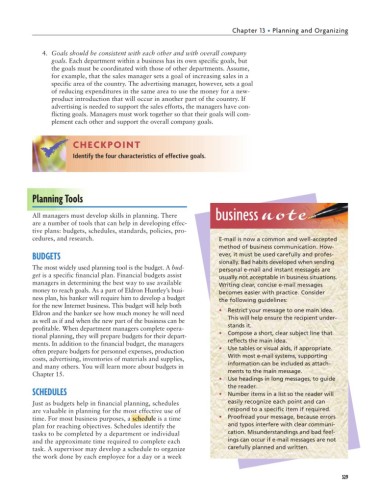Page 342 - Business Principles and Management
P. 342
Chapter 13 • Planning and Organizing
4. Goals should be consistent with each other and with overall company
goals. Each department within a business has its own specific goals, but
the goals must be coordinated with those of other departments. Assume,
for example, that the sales manager sets a goal of increasing sales in a
specific area of the country. The advertising manager, however, sets a goal
of reducing expenditures in the same area to use the money for a new-
product introduction that will occur in another part of the country. If
advertising is needed to support the sales efforts, the managers have con-
flicting goals. Managers must work together so that their goals will com-
plement each other and support the overall company goals.
CHECKPOINT
Identify the four characteristics of effective goals.
Planning Tools
All managers must develop skills in planning. There business note
are a number of tools that can help in developing effec-
tive plans: budgets, schedules, standards, policies, pro-
cedures, and research. E-mail is now a common and well-accepted
method of business communication. How-
BUDGETS ever, it must be used carefully and profes-
sionally. Bad habits developed when sending
The most widely used planning tool is the budget. A bud- personal e-mail and instant messages are
get is a specific financial plan. Financial budgets assist usually not acceptable in business situations.
managers in determining the best way to use available Writing clear, concise e-mail messages
money to reach goals. As a part of Eldron Huntley’s busi- becomes easier with practice. Consider
ness plan, his banker will require him to develop a budget the following guidelines:
for the new Internet business. This budget will help both
Eldron and the banker see how much money he will need • Restrict your message to one main idea.
as well as if and when the new part of the business can be This will help ensure the recipient under-
profitable. When department managers complete opera- stands it.
tional planning, they will prepare budgets for their depart- • Compose a short, clear subject line that
ments. In addition to the financial budget, the managers reflects the main idea.
often prepare budgets for personnel expenses, production • Use tables or visual aids, if appropriate.
costs, advertising, inventories of materials and supplies, With most e-mail systems, supporting
and many others. You will learn more about budgets in information can be included as attach-
Chapter 15. ments to the main message.
• Use headings in long messages, to guide
the reader.
SCHEDULES • Number items in a list so the reader will
Just as budgets help in financial planning, schedules easily recognize each point and can
are valuable in planning for the most effective use of respond to a specific item if required.
time. For most business purposes, a schedule is a time • Proofread your message, because errors
plan for reaching objectives. Schedules identify the and typos interfere with clear communi-
tasks to be completed by a department or individual cation. Misunderstandings and bad feel-
and the approximate time required to complete each ings can occur if e-mail messages are not
task. A supervisor may develop a schedule to organize carefully planned and written.
the work done by each employee for a day or a week
329

